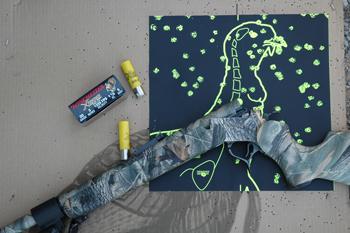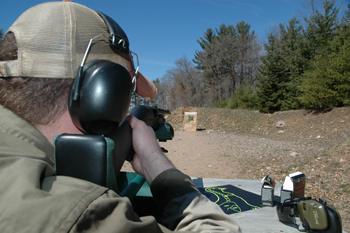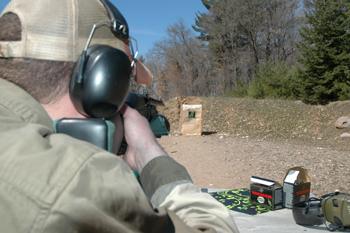Is 50 The New 40? - Long Range Turkey Hunting
By J. Schlender
©Copyright 2009, Turkey & Turkey Hunting
The author thinks it is, but ultimately it's a question only you can answer.

I recently read a headline joyously proclaiming that "50 is the new 40!"
"Cool!" I thought while wondering how a discussion about turkey shooting yardages had found its way into a weekly news magazine.
Of course, the article wasn't about turkeys, but rather how the 21st century approach to aging is that in mind, body and spirit, you're only as old as you feel, or something like that. While I certainly hope that's true, and as much as I've already tired of the "this is the new that" cliché, I can't help but apply it to turkey hunting by asking, seriously: Is 50 yards the new 40 yards?
First, a disclaimer: I don't think it does our sport or our reputation as hunters any good to encourage long-distance shots at turkeys. But what's long distance? I don't know, and that's the point of asking the question. It's not a simple one to answer because, as a friend often replies when I ask him what I think is a simple question: "Well, there are two ways of looking at that." Which is his way of avoiding answering me.
But in this case, there really ARE two ways of looking at it: First, what are your self-imposed ethics regarding shooting distances? And second, what kind of performance is your gun and ammo capable of?
As I write this, there is quite a spirited debate raging about appropriate shooting distances in the Shooting portion of the Message Board on www.turkeyandturkeyhunting.com. While it makes for interesting reading, there can never be closure. One group approaches it from an ethical viewpoint and the other approaches from the hardware viewpoint.
There are gun-choke-load combinations that absolutely will kill a turkey at 70 yards. That's fact. Therefore, the only question remaining is: Just because you CAN kill a turkey at 50 (or 60 or 70) yards, should you?

40? Says Who?
I think we would all agree that the closer you bring a turkey before pulling the trigger, the more exciting and rewarding the experience is. But that doesn't have anything to do with ethics. That's a personal choice. The ethical part comes into play when you try to stretch the limits of the capabilities of your shooting gear.
Somewhere along the line 40 yards became the ethical standard. You figured out how to call a turkey inside of that distance before you considered taking the shot. That's probably because up until about a decade ago when manufacturers started supplying truly excellent turkey choke tubes and superior ammo (meaning shells that were designed for turkey-killing performance, and not simply stuffed with extra powder and pellets) it was tough to consistently get good patterns much beyond that distance.
Today, in terms of equipment performance (come on, say it with me), 50 IS the new 40. Tungsten-alloy pellets have had the biggest impact on our ability to shoot with confidence beyond 40 yards, but the excellent choke tubes we have available further allow us to wring out every bit of their performance.
Now, if you're using the same gun and shells today that you were in 1992 (not that there would be anything wrong with that) and it was a 40-yard gun then, and you have a gobbler at 50 yards and decide to take the shot just to see what will happen, well, that's not right. I think this is where the discussion often turns into an argument. The ethics of always striving for a clean kill haven't changed, but the circumstances that have given us the ability to shoot farther have changed dramatically.

Incident on the Prairie
This topic has been in the cluttered background of my mind for quite a while. But an incident in South Dakota last spring brought things into sharper focus for me.
I mentioned that hunt in my March column with regard to the stock design on Remington's new 11-87 Sportsman ShurShot Turkey model. But an important detail I didn't get into in that issue was the fact I used that gun to kill a Merriam's at 60 yards.
When I paced off the kill, which I was sure was no farther than 50 yards when I pulled the trigger, I didn't know if I should be thrilled or embarrassed. Long story short: I'd had the gobbler at nearly half that distance, but he'd come in so quickly I hadn't been able to get my gun up and ready to shoot. By the time I was able to aim properly, he had started skirting around me. The he popped into strut and wandered several more yards before finally poking his head up and giving me a shot.
As someone back at camp pointed out when I sheepishly related my story, "Heck, that's a rifle shot. Can you even say you called him in?" Yeah, whatever. If I'd have thought that Merriam's standing in the big wide open was at 60 yards, I wouldn't have shot. But I really thought he was at 50. It proves – not that I'm the first one to say it – that in turkey hunting, there's no such thing as being overgunned.
I was shooting Remington's Wingmaster HD tungsten-alloy shells in the 31/2-inch, No. 4 loading. I'd patterned the gun at 40 yards through the factory turkey tube that came with the gun. The ridiculously dense pattern at 40 yards, and the fact I'd tinkered with other versions of these shells the year before, told me I had a genuine 50-yard turkey gun.
As for personal ethics, in case you're wondering, my take on it is that I'm out there to shoot a turkey. Passing a shot on a bird that's beyond 40 yards while you're holding a 50-yard gun in your hands makes no sense to me. At the same time, I'd feel kind of funny about shooting one with a rifle in a state where it's legal. But to each his own.


Only You
Patterns aside, if you want to witness some impressive downrange energy, take any of the heavier-than-lead offerings to the range and shoot into plywood or phone books or whatever other medium you'd like to use and then compare to lead turkey loads. The results will end any personal debate you might be waging with yourself about whether today's products limit us to 40-yard shots.
After that, the only question that remains is how close a turkey should be before you'll feel good about pulling the trigger. And that, friends, is a question only one person can answer.
This article was originally published in Turkey & Turkey Hunting, 2009 and is used here with permission of the publisher. To find more articles on various turkey hunting topics, log on to www.turkeyandturkeyhunting.com..
By J. Schlender
©Copyright 2009, Turkey & Turkey Hunting
The author thinks it is, but ultimately it's a question only you can answer.

I recently read a headline joyously proclaiming that "50 is the new 40!"
"Cool!" I thought while wondering how a discussion about turkey shooting yardages had found its way into a weekly news magazine.
Of course, the article wasn't about turkeys, but rather how the 21st century approach to aging is that in mind, body and spirit, you're only as old as you feel, or something like that. While I certainly hope that's true, and as much as I've already tired of the "this is the new that" cliché, I can't help but apply it to turkey hunting by asking, seriously: Is 50 yards the new 40 yards?
First, a disclaimer: I don't think it does our sport or our reputation as hunters any good to encourage long-distance shots at turkeys. But what's long distance? I don't know, and that's the point of asking the question. It's not a simple one to answer because, as a friend often replies when I ask him what I think is a simple question: "Well, there are two ways of looking at that." Which is his way of avoiding answering me.
But in this case, there really ARE two ways of looking at it: First, what are your self-imposed ethics regarding shooting distances? And second, what kind of performance is your gun and ammo capable of?
As I write this, there is quite a spirited debate raging about appropriate shooting distances in the Shooting portion of the Message Board on www.turkeyandturkeyhunting.com. While it makes for interesting reading, there can never be closure. One group approaches it from an ethical viewpoint and the other approaches from the hardware viewpoint.
There are gun-choke-load combinations that absolutely will kill a turkey at 70 yards. That's fact. Therefore, the only question remaining is: Just because you CAN kill a turkey at 50 (or 60 or 70) yards, should you?

40? Says Who?
I think we would all agree that the closer you bring a turkey before pulling the trigger, the more exciting and rewarding the experience is. But that doesn't have anything to do with ethics. That's a personal choice. The ethical part comes into play when you try to stretch the limits of the capabilities of your shooting gear.
Somewhere along the line 40 yards became the ethical standard. You figured out how to call a turkey inside of that distance before you considered taking the shot. That's probably because up until about a decade ago when manufacturers started supplying truly excellent turkey choke tubes and superior ammo (meaning shells that were designed for turkey-killing performance, and not simply stuffed with extra powder and pellets) it was tough to consistently get good patterns much beyond that distance.
Today, in terms of equipment performance (come on, say it with me), 50 IS the new 40. Tungsten-alloy pellets have had the biggest impact on our ability to shoot with confidence beyond 40 yards, but the excellent choke tubes we have available further allow us to wring out every bit of their performance.
Now, if you're using the same gun and shells today that you were in 1992 (not that there would be anything wrong with that) and it was a 40-yard gun then, and you have a gobbler at 50 yards and decide to take the shot just to see what will happen, well, that's not right. I think this is where the discussion often turns into an argument. The ethics of always striving for a clean kill haven't changed, but the circumstances that have given us the ability to shoot farther have changed dramatically.

Incident on the Prairie
This topic has been in the cluttered background of my mind for quite a while. But an incident in South Dakota last spring brought things into sharper focus for me.
I mentioned that hunt in my March column with regard to the stock design on Remington's new 11-87 Sportsman ShurShot Turkey model. But an important detail I didn't get into in that issue was the fact I used that gun to kill a Merriam's at 60 yards.
When I paced off the kill, which I was sure was no farther than 50 yards when I pulled the trigger, I didn't know if I should be thrilled or embarrassed. Long story short: I'd had the gobbler at nearly half that distance, but he'd come in so quickly I hadn't been able to get my gun up and ready to shoot. By the time I was able to aim properly, he had started skirting around me. The he popped into strut and wandered several more yards before finally poking his head up and giving me a shot.
As someone back at camp pointed out when I sheepishly related my story, "Heck, that's a rifle shot. Can you even say you called him in?" Yeah, whatever. If I'd have thought that Merriam's standing in the big wide open was at 60 yards, I wouldn't have shot. But I really thought he was at 50. It proves – not that I'm the first one to say it – that in turkey hunting, there's no such thing as being overgunned.
I was shooting Remington's Wingmaster HD tungsten-alloy shells in the 31/2-inch, No. 4 loading. I'd patterned the gun at 40 yards through the factory turkey tube that came with the gun. The ridiculously dense pattern at 40 yards, and the fact I'd tinkered with other versions of these shells the year before, told me I had a genuine 50-yard turkey gun.
As for personal ethics, in case you're wondering, my take on it is that I'm out there to shoot a turkey. Passing a shot on a bird that's beyond 40 yards while you're holding a 50-yard gun in your hands makes no sense to me. At the same time, I'd feel kind of funny about shooting one with a rifle in a state where it's legal. But to each his own.


Only You
Patterns aside, if you want to witness some impressive downrange energy, take any of the heavier-than-lead offerings to the range and shoot into plywood or phone books or whatever other medium you'd like to use and then compare to lead turkey loads. The results will end any personal debate you might be waging with yourself about whether today's products limit us to 40-yard shots.
After that, the only question that remains is how close a turkey should be before you'll feel good about pulling the trigger. And that, friends, is a question only one person can answer.
This article was originally published in Turkey & Turkey Hunting, 2009 and is used here with permission of the publisher. To find more articles on various turkey hunting topics, log on to www.turkeyandturkeyhunting.com..

